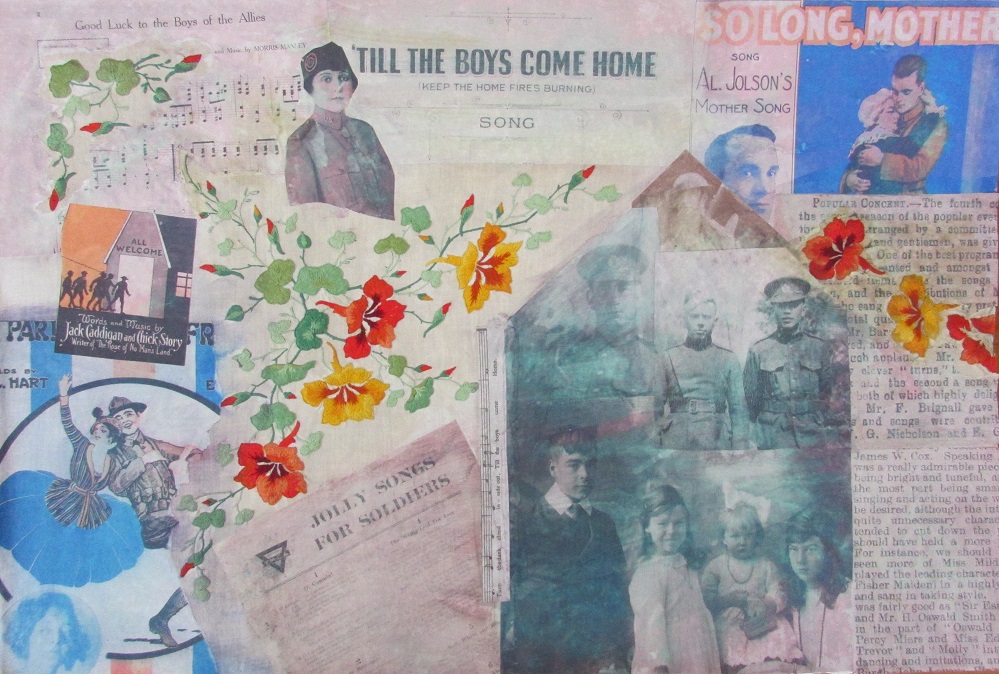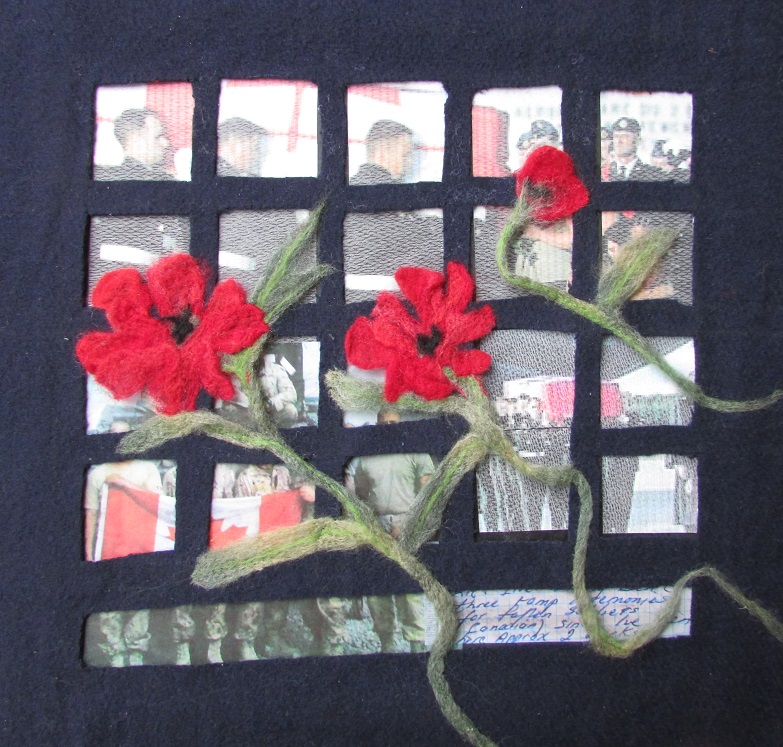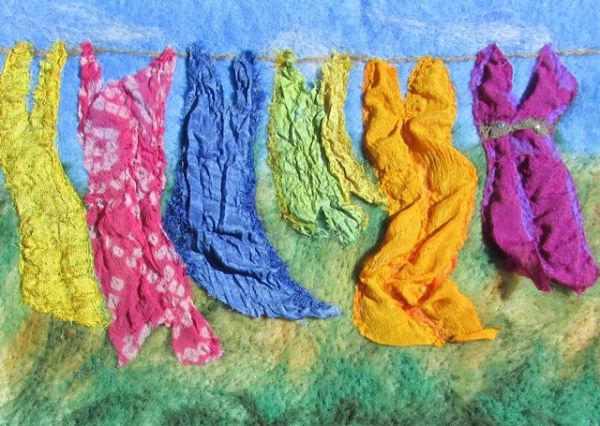By Taryn McIntosh
All images and copyright: Heather Nagel
Heather Nagel is a mixed media visual artist living in Eden Mills. She sat down with me to talk about her art and the pieces she’s made in remembrance of our veterans.
Taryn: Can you tell me a little bit about yourself and your artistic background?
Heather: I guess I’ve always been creative – my sisters, who were very academic, called it making a mess.I realize that was probably my creative side. And back when I was growing up we didn’t have access to many art supplies, so I just kind of made do. I grew up on a farm and a lot of it was found stuff. You never knew what would turn up under my bed.
T: What inspires your work generally, and do you have a favourite subject or theme in your artwork?
H: I really love doing fibre art. It’s the texture with felting because wool has a wonderful feel and the dyed wool is very vibrant. But then I incorporate things like bamboo and silk and flax linen and found objects for interest. I think nature based and even if it’s an abstract piece it still has to have a little bit of nature in it. Even this morning when I did the silk dresses, they’re on a clothesline outside with blue sky and blowing grass.
T: Could you expand a little bit on your Wall of Art submission pieces?
H: When the hundredth anniversary celebration came out and they announced the theme I thought ‘that’s really interesting!’ We’ve learned about that time period through a lot of stories and books but the art brings it to a different level. When my daughter was in grade 7 the teacher told them stories about WWI and they were just riveted, they were fascinated, and he passed the stories and history along that way. So then, because I’m a visual person, I put the stories into a visual art form. I did the poppy one, which is at the museum as we speak and it incorporates letters, because the letters were the only way people had to communicate. And they were away for years, sometimes they were away for five years, so the letters were precious. The next one was “Home Front” and I had old sheet music from WWI which I incorporated along with linen and stuff like that. For the theme “We Remember” I thought well, everybody remembers the parades of soldiers coming home and how exciting it was just to see someone after that long, but what about the people who didn’t survive? So I thought ‘I’ll do a piece about that.. That was the background of the piece. I wrote a little description “Young man coming home surrounded by family and friends” so that would be like “oh a celebration, you know, like it would be so exciting and everyone’s hugging each other but it wasn’t, it was a young man coming home who didn’t survive, is the background of that. I felt that it was maybe offensive to some people because people want joy in art, they want to see happiness. And in my piece they’re in uniforms – there’s a lot of negativity around young men wearing uniforms – and then a family meeting a person coming off an airplane in a casket, that’s sadness. It’s like oh you can’t do that, you can’t put that in art.

Til The Boys Come Home
T: I know what you mean. When I was at the play In Flanders Fields at McCrae House, I was disturbed by the thought that the trees in the backyard covering this recreated trench were the same that John McCrae would have seen as a child. I think feeling disturbed or feeling those negative emotions is sometimes necessary to respect those who were in that situation and felt that way themselves.
H: Exactly, and the topic was “We Remember” so we should remember the sadness as well as the celebration, because no one wants war, no one wants a repeat of that, no one wants to remember that someone is not alive, that people have died, but you have to respect their life in their death, in that way. So that’s why I did that piece. They were little two-inch windows, they were a bit ragged, and then I put silk over the pictures to make them look distant, so it wasn’t easy to see what was in the pictures, you had to really look at it.

Coming Home
T: I was wondering what inspired that format, the way you layered it.
H: Well the layering is just, it’s a very complicated issue because the young man in the picture who died, he joined a peace-keeping mission and he was excited about helping women and children with schools and roads and things like that so they could have more freedom. And then the peace-keeping mission turned into more of a combat mission and he was killed. So there were layers of, even in that peace-keeping mission, it wasn’t clear what was going to happen. It definitely wasn’t a safe place to go, and the whole situation was unclear. Also, a lot of young men went who survived have come back, and they’re veterans, but they’re young, and that’s complicated too. So that’s why I took the window approach, there are many different ways of looking at it.
T: So it’s kind of fragmented bits of images to represent that.
H: Yes exactly.
T: And you use photographs too, just to play with different concepts like that?
H: Right, so I don’t ever have rules about what I can put together and where it goes. I mean it still has to have composition and balance and your colours have to work…
T: Yes, of course you still have certain aesthetic choices you’re making through it.
H: Mhm! You might encounter something and just go “wow” and then use it for a piece. So I’m not afraid to try different things.
T: The poppy seems to hold different importance for everyone, but I’ve seen it throughout your work. What meaning does it hold for you?
H: Well, as the symbol in the poem In Flanders Fields. In some of my work I try to use it as a symbol of remembrance not just on November 11 but year round. And I love poppies, they just come in so many colours and they’re so rugged but they’re so… delicate, more delicate than silk. I love working with silk and silk is stronger than most fabrics; they used to make parachutes out of silk. So the poppy is kind of like the fibre I use. It’s deceiving how strong it is.
T: I thought it was really interesting and beautiful the way you used poppies in that last piece, because like in the poem, the poppies contrast the death, as if this life is growing because of the death; the poppies wouldn’t have grown if it wasn’t for the destruction and disturbance in the field. I think you incorporated that really well.
H: Thank you. Yeah, that’s why I put it on top of the image. When everything else is gone, we still have these poppies.
T: What art/other artists inspire you?
H: Oh, that’s really hard to answer! There are a lot of fibre artists that are amazing. Fiona Duthie, from Salt Spring Island, she does the most creative and imaginative work, it’s just stunning. I live in Eden Mills, so I’m inspired by a lot of the local artists there. I love hearing their stories about their art, and they’re all different media artists. I am inspired by them because they are all very generous and kind and supportive. Jim Reid is very cool because he does all kinds of different things, he looks at the history of old buildings and their significance, and he’s local. So those people, and then some contemporary artists too, like Arman…I saw Arman’s work in Ottawa at the gallery and it was just so different and so inspiring. There are the masters too, like Monet. I love looking; it’s always a feast for the eyes looking at the masters. I just like a variety, everything is inspiring to me.
T: So is it mostly visual art that inspires you or other types of art like music, or literature…
H: I like all types of music too. It depends on what I’m working on. Sometimes it’s classical, jazz and then there’s just out-there music like Apocalyptica, things like that. I think I’m a variety person, I love change. Even when I think of graffiti, if you know the story behind it, or if you really look into it, you know? Is a plain brick wall more beautiful than someone’s art, something that someone worked on? People see different things as art, it might be a tattoo, it might be graffiti, or it might be a piece of furniture. So it’s important to me to respect other people’s opinions about what they think is artistic and beautiful. We all see differently.








